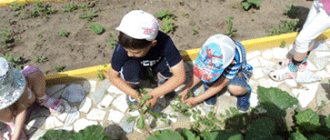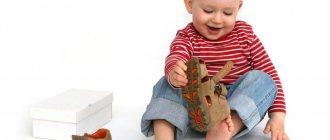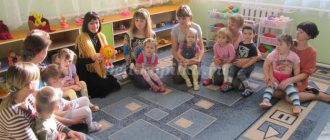Card index of games for developing self-service skills in the younger group
Natalia Yankova
Card index of games for developing self-service skills in the younger group
Goal: Creating conditions for the development of independence , focus, self-regulation of one’s own actions.
Tasks:
1. Continue teaching children independently in a certain sequence (putting on and taking off clothes, unbuttoning and fastening buttons, folding, hanging clothes, etc.).
2. Develop neatness, the ability to notice disorder in clothing and eliminate it with a little help from adults.
3. Continue to teach correctly, use soap, carefully wash your hands, face, ears, wipe yourself dry after washing, hang the towel back, use a comb, and a handkerchief.
4. Learn to use tablespoons, teaspoons, forks, and napkins correctly.
Didactic games
Hygiene rules"
Goal: creating conditions for consolidating cultural and hygienic skills (washing, dressing, brushing teeth, combing your hair, bathing, developing the ability to show these movements with the help of facial expressions and gestures and guess by showing them.
Procedure: the teacher asks the children, using facial expressions and gestures, to show how they wash themselves (dress, brush their teeth, etc., following the sequence of performing these skills . Or the teacher shows, using facial expressions and gestures, what he is doing, and the children guess.
"Pick a Pair"
Goal: creating conditions for the correlation of objects in the pictures with actions ; strengthening self-care skills .
Equipment: subject pictures : vacuum cleaner, comb, soap, toy cabinet; subject pictures : cleaning the apartment, boots, clothes, toys.
Progress: children carefully examine the pictures , compare them and select pairs, explaining their choice.
"What's first, what's next"
Goal: creating conditions for developing the ability to arrange pictures in order of plot development , using an auxiliary tool; write short stories.
Procedure: children are offered several pictures connected by one plot, arrange them in the order of the events that happened and compose a story based on them. For example: a boy lies in bed, does exercises, washes himself, wipes himself with a towel; girl washes her hands, has lunch, plays with a doll
"Hygiene rules"
.
Goal: to create conditions for clarifying children’s ideas about hygiene skills and forming the foundations of a healthy lifestyle.
Move: using a counting rhyme, the driver is selected, he leaves the group . The teacher and the children agree on who will portray what and what. Then the driver is invited, the children take turns demonstrating skills using gestures and facial expressions. The presenter must guess what the children are showing: washing, brushing teeth, combing their hair, bathing.
"Find a Pair"
Goal: to create conditions for the development of skills to distinguish between paired shoes and clothes.
Equipment: shoes cut out of cardboard : boots, shoes, gloves, socks, mittens, Masha doll.
Progress: the teacher introduces the children to a game situation: “Masha, the confused one, scattered her clothes and shoes in different corners. She can't find anything on her own. She found one sock, but can’t find the other, found one boot, but doesn’t know where the other one is, etc.” The children are invited to help Masha, who is at a loss, find a couple of items of clothing and shoes. The teacher presents the right version of the pair (sock, boot, etc.)
and offers to choose the left one. At the same time, the instruction is given:
. ”
“Let’s choose clothes for the dolls”
Goal: creating conditions for developing the ability to name items of clothing, differentiate clothes for boys and girls, and consistently dress a doll.
Equipment: two dolls - Mitya doll and Katya doll, sets of clothes for girl and boy dolls.
Proceedings Teacher: “Look, children, dolls came to visit us, but they can’t get dressed, they mixed up their clothes and can’t find their things. Let’s help them figure out where and whose things are.” The teacher asks: “What do girls wear and what do boys wear?”
After the children choose clothes for the dolls, one child begins to dress Mitya, and the other - Katya. At this time, the teacher focuses the children’s attention on the sequence of dressing. The teacher always praises the children for the fact that the dolls are dressed correctly and beautifully.
Game situations
"Let's teach a doll to wash its hands"
Goal: creating conditions for consolidating knowledge about personal hygiene items, sequence of actions, and developing the habit of neatness.
Equipment: personal hygiene items, dolls.
Procedure: children sit in front of a play corner, which contains a washbasin and a cabinet with a towel. The teacher brings the doll Anya with dirty hands. Doll Anya is going to visit and “changes clothes”
.
She “takes”
the dress
with “dirty hands”
and stains remain on the dress.
Seeing this, the Anya doll begins to cry. The teacher says: “Oh, the Anya doll took the dress with dirty hands! Children, what needs to be done? (children's answers)
Teacher: That's right, the doll needs to wash its hands. Don’t cry, Anya, we’ll wash your hands now.”
“Let’s give the dolls different hairstyles”
Goal: creating conditions for consolidating hair care skills , clarifying the names of the items necessary for this, and forming the concept of “neat”
appearance.
Equipment: dolls, combs, hairpins.
Procedure: the teacher invites the children to comb the dolls' hair.
"Tanya caught a cold"
Goal: creating conditions for the development of skills and the formation of the skill of using a handkerchief.
Equipment: handkerchief
Progress: the teacher asks: why do people need a handkerchief?
And then he offers the children various situations, which they play out together with the kids:
— What should you do if you want to sneeze? Etc.
“Let’s dress the doll for a walk”
Goal: to create conditions for developing children’s skills in dressing a doll according to the weather.
Equipment: paper doll with various clothes
Progress: the teacher says that the doll is going for a walk, but doesn’t know what to wear, it’s winter and it’s very cold outside (various situations)
.
Children "dress"
doll and explain their choice.
Exercise
"Soap Gloves"
Goal: to create conditions for the development of children’s ability to soap their hands well from the outside and inside until bubbles form.
Equipment: bathroom, baby soap, towel.
Progress: Teacher: “We’ll go to the sink, open the tap and let warm water in, and now we’ll take the soap and make ourselves beautiful “white gloves.” The teacher explains the process of soaping hands step by step. Children soap their hands without water until white foam forms, then the children put the soap in a soap dish and distribute the soap over their hands in a circular motion. The teacher draws the children’s attention to the fact that they have created fashionable “white gloves.” It is advisable to use various poems and nursery rhymes in your work. For example:
“Okay, okay, wash your little hands with soap, Clean palms, here’s bread and spoons for you! Water gurgles in the tap. Very cool!
Washes herself (child’s name)
»
"Our things go to bed"
Goal: to create conditions for the development of children’s ability to neatly put things on a high chair.
"We'll tuck in our jerseys."
Goal: to create conditions for the development of children’s ability to tuck in T-shirts and T-shirts.
We do everything in order"
Goal: to create conditions for the development of children’s ability to take off and put on clothes in a certain order.
"Turn out your tights"
Goal: to create conditions for the development of children’s ability to turn tights inside out correctly.




